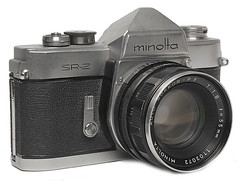Difference between revisions of "Minolta SR-2"
m (edit txt) |
m (corrected error) |
||
| Line 18: | Line 18: | ||
| − | However, just as important for the Chiyoda Kogaku success is the fact that they had to their disposal one of the most experienced and finest optical works, with advanced coating facilities and brilliant lens designers. Right from the introduction of SR-2, a large range of lenses and accessories was available. Several of the early lenses was superior, like the Rokkor PF 1:2 f=100mm and the remarkable Macro Rokkor QF 1:3.5 f=50mm. The latter had Leica thread mount, but was supplied with a Minolta bayonet mount adapter, it focused from infinity to 2 | + | However, just as important for the Chiyoda Kogaku success is the fact that they had to their disposal one of the most experienced and finest optical works, with advanced coating facilities and brilliant lens designers. Right from the introduction of SR-2, a large range of lenses and accessories was available. Several of the early lenses was superior, like the Rokkor PF 1:2 f=100mm and the remarkable Macro Rokkor QF 1:3.5 f=50mm. The latter had Leica thread mount, but was supplied with a Minolta bayonet mount adapter, it focused from infinity to 1:2 without the need for the included 1:1 intermediate ring. A remarkable curiosity is the fact that they subcontracted the manufacture of the macro bellows to Novoflex, the supplier of bellows to manufacturers like Hasselblad and Zeiss Ikon. |
The introduction of the Minolta SR-2 marked the beginning of Chiyoda Kogau's remarkable success subsequently placing the company among the few world-leading camera manufacturers for many decades to come. In July 1962, as the result of this international recognition, the company name was changed to Minolta Camera Company Ltd. | The introduction of the Minolta SR-2 marked the beginning of Chiyoda Kogau's remarkable success subsequently placing the company among the few world-leading camera manufacturers for many decades to come. In July 1962, as the result of this international recognition, the company name was changed to Minolta Camera Company Ltd. | ||
Revision as of 14:25, 27 February 2009
The Minolta SR-2 came in 1958 as the first 35mm SLR camera from Chiyoda Kogaku. Having a remarkably advanced design, it paved the way for a whole series of successfull models for several decades to come, the same body being continuously refined right up to and including the Minolta XE-1 of 1975, which by the way, became the basis for Leica R3. In this model all the features to be included in any modern film based SLR camera came together for the first time: A bright Penta prism finder with rapid return mirror, a wide bayonet lens mount for fast and convenient lens change with an internal automatic lens diaphragm mechanism, a single knob stationary shutter speed dial, a fast right thumb film advance lever with coaxial shutter release, a combined rewind crank and back opening knob, hinged back door with automatic frame counter reset and film type reminder dial, FP and X PC sync terminals, and a convenient selftimer sturdy enough to double as a finger grip. The only important thing missing was the provision for an exposure meter. This was rectified in 1960 with the introduction of the model SR-3 having provision for a clip-on shutter speed dial coupled selenium meter, and in 1962, came the first 35mm SLR camera with a built-in CdS meter with the introduction of the model SR-7.

|
- Penta prism
- Instant return mirror
- Bayonet lens mount with internal diaphragm operating lever
- Fast film advance / shutter tensioning lever with integrated shutter release knob
- Automatic preset lenses, closing aperture to preset value prior to exposure
- All shutter speeds set on a single stationary dial, 1 to 1/1000 sec. pluss B
- Combined rewind crank and back door release by pulling the knob up
- Internal frame counter with automatic reset when opening the back
However, just as important for the Chiyoda Kogaku success is the fact that they had to their disposal one of the most experienced and finest optical works, with advanced coating facilities and brilliant lens designers. Right from the introduction of SR-2, a large range of lenses and accessories was available. Several of the early lenses was superior, like the Rokkor PF 1:2 f=100mm and the remarkable Macro Rokkor QF 1:3.5 f=50mm. The latter had Leica thread mount, but was supplied with a Minolta bayonet mount adapter, it focused from infinity to 1:2 without the need for the included 1:1 intermediate ring. A remarkable curiosity is the fact that they subcontracted the manufacture of the macro bellows to Novoflex, the supplier of bellows to manufacturers like Hasselblad and Zeiss Ikon.
The introduction of the Minolta SR-2 marked the beginning of Chiyoda Kogau's remarkable success subsequently placing the company among the few world-leading camera manufacturers for many decades to come. In July 1962, as the result of this international recognition, the company name was changed to Minolta Camera Company Ltd.
Links
- The SR-2 page at the Manual Minolta website
- Minolta Sr-2 at Sylvain Halgand's collection d'appareils
| Minolta Classic Cameras |
|---|
| Vest (or Best) | V2 | SR-2 | SRT 101 | XE | XD | CLE | 7000 | 9000 | 800 si |